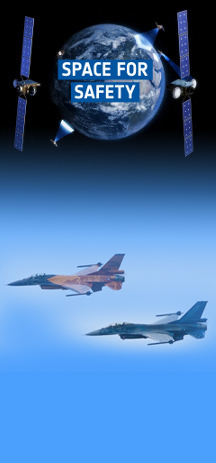Background
Initiated and facilitated by the Integrated Applications Promotion (IAP) programme of the European Space Agency (ESA), the FlySafe project involved users, developers and service providers from the Royal Netherlands Air Force (RNLAF), the Belgian and French Air Forces, the German Bundeswehr, Computational Geo-Ecology at the University of Amsterdam, TNO Defence, Security and Safety, Robin Radar Systems, TriOpSys, SARA Computing and Networking Services, the Institute for Avian Research (Vogelwarte Helgoland), the Swiss and Dutch Ornithological Institutes (SOI and SOVON), Royal Netherlands Meteorological Institute (KNMI), Meteo France, Belgian Meteorological Institute, IDA TU Braunschweig, Thales Raytheon Electronic Systems and Thales Alenia Space. The goal of the project was to improve bird strike prevention for en-route military aviation by improving the quality and availability of BIRDTAM’s which inform pilots about bird densities in the air. FlySafe combines the necessary and available space and ground-based systems, and the scientific research and technological applications from various user communities, in order to provide a sustainable service for the observation of large-scale bird migration.
In 2009, Dutch and Belgian air forces proposed the creation of an operational service, to be hosted by the Royal Netherlands Meteorological Institute (KNMI). This project implemented in partnership between ESA, RNLAF and BAF established the set of services presented in this website:
- Bird migration forecasts for North Sea, Northern Netherlands, Central Belgium and Eastern Belgium generated by FlySafe bird migration models;
- Radar measurements of local bird movements by 2 Air Defence radars (1 Belgian + 1 Dutch) and 5 weather radars (3 Belgian + 2 Dutch).
Recent developments
In 2013 a four year e-COST (European Cooperation in Science and Technology) Action within the Domain Earth System Science and
Environmental Management was launched, called ENRAM, the European Network for the Radar surveillance of Animal Movement
(www.enram.eu). The main objective of ENRAM is to merge expertise to utilize weather radars
to monitor the aerial movement of animals across Europe for a broad front of stakeholders. The network of operational weather
radars in Europe are organized in OPERA (Operational Program on the Exchange of Weather Radar Information). The harmonization
of radar measurements and the retrieval algorithms to compare data are needed. Therefore, the main objective of ENRAM is to
foster international and multi-disciplinary collaboration by establishing a European network of researchers with expertise in
ecology, ornithology, entomology, meteorology, engineering, mathematics, visual analytics and computer sciences. Flight safety,
as one of the stakeholders, benefits greatly from this network through the standardization of bird retrieval algorithms, which
were developed within the project. In partnership between the Air Forces of Poland, the Netherlands, Belgium, the German
Bundeswehr and the Royal Netherlands Meteorological Institute (KNMI) expanded the services presented on this website:
- Bird density (expressed as BIRDTAM-values used in aviation) altitude profiles of weather radars in Germany, the Netherlands and Belgium;
- A radar composite of biomass (birds and insects) through the lowest air layer (roughly below 1 km) of Germany, the Netherlands and Belgium;
Future perspective
In the recent RNLAF project Bird Avoidance System (2016-2020) it is planned to (1) further improve and standardize the bird
retrieval algorithms; (2) expansion of the altitude profiles with spatial images of bird migration on a regional and continental
scale and (3) improvement of statistical predictions of bird migration intensity based on the weather radar network.
Air Forces from other countries are encouraged to join forces with our FlySafe initiative.






